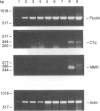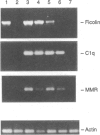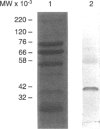Abstract
Ficolin is characterized by the presence of both collagen-like and fibrinogen-like sequences, and potentially has a similar overall structure as the complement protein C1q and the collectins. Previous studies have reported the presence of human ficolin mRNA predominantly in peripheral blood leucocytes. In the present study, the cellular origin of human ficolin was investigated in further detail. Preliminary studies using reverse transcriptase-polymerase chain reaction (RT-PCR) showed that ficolin mRNA was synthesized by U937 cells, a human monocyte cell line. This finding suggested that blood monocytes also normally synthesize human ficolin. Peripheral blood monocytes from adult human donors were harvested at serial time-points (0-20 hr) after adhesion to tissue culture plates, and total RNA was isolated and assayed for ficolin mRNA by RT-PCR. Ficolin mRNA was highly expressed in monocytes throughout the first 20 hr of adhesion. In contrast, C1q and mannose receptor mRNA were not detectable during the first 8 hr of adhesion, but were highly expressed by 20 hr. Cells were harvested at longer time intervals (1, 2, 4, 6 and 8 days) to determine whether ficolin expression was temporally regulated at later stages of monocyte differentiation. Ficolin mRNA levels decreased sharply from day 1 to day 6. In contrast, the levels of both C1q and mannose receptor mRNA showed no changing trend. These results are consistent with the absence of ficolin expression in many macrophage-rich tissues previously reported. The origin of ficolin from monocytes, together with its structural similarity to C1q and the collectins, raises the possibility that ficolin may be another plasma protein capable of binding to surface structures of micro-organisms. Escherichia coli was therefore incubated with human serum, and bound proteins, after elution with sugars, were analysed by Western blotting using an antiserum raised against a synthetic ficolin peptide. The antiserum identified a polypeptide of approximately 42000 MW, which is similar in size to that of ficolin as predicted from its cDNA-derived sequence.
Full text
PDF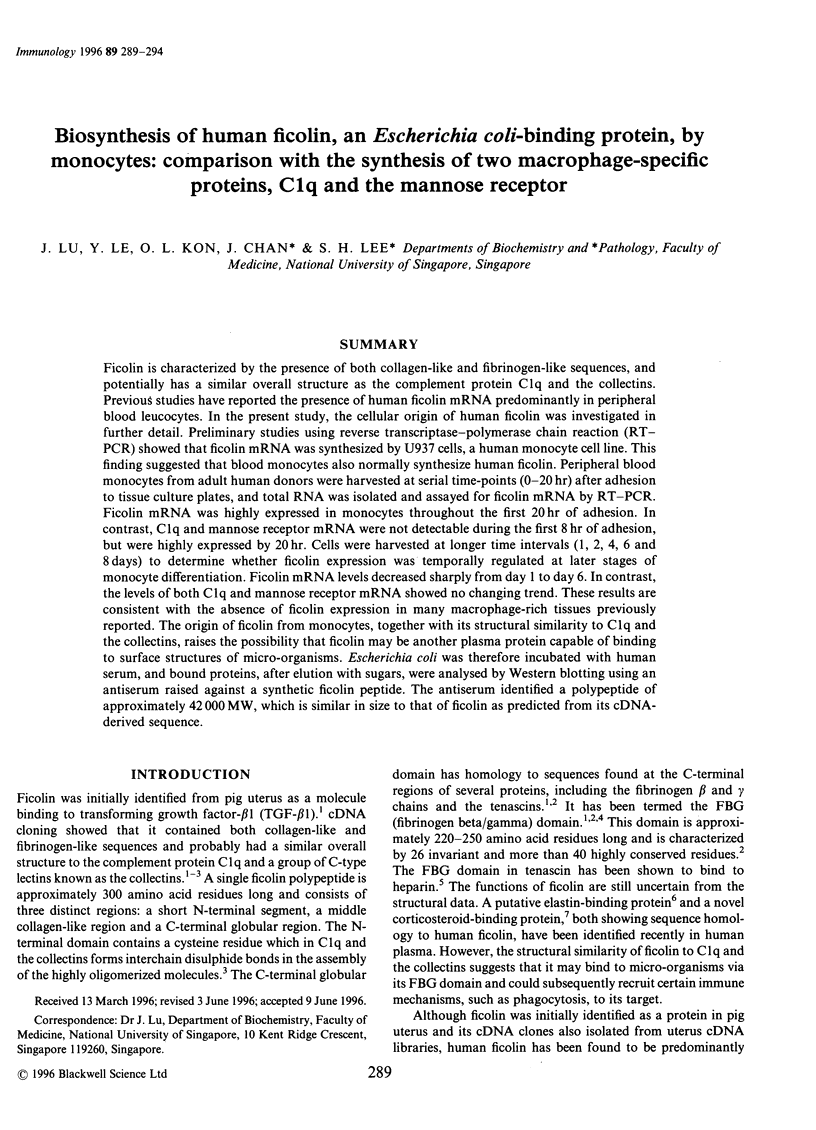
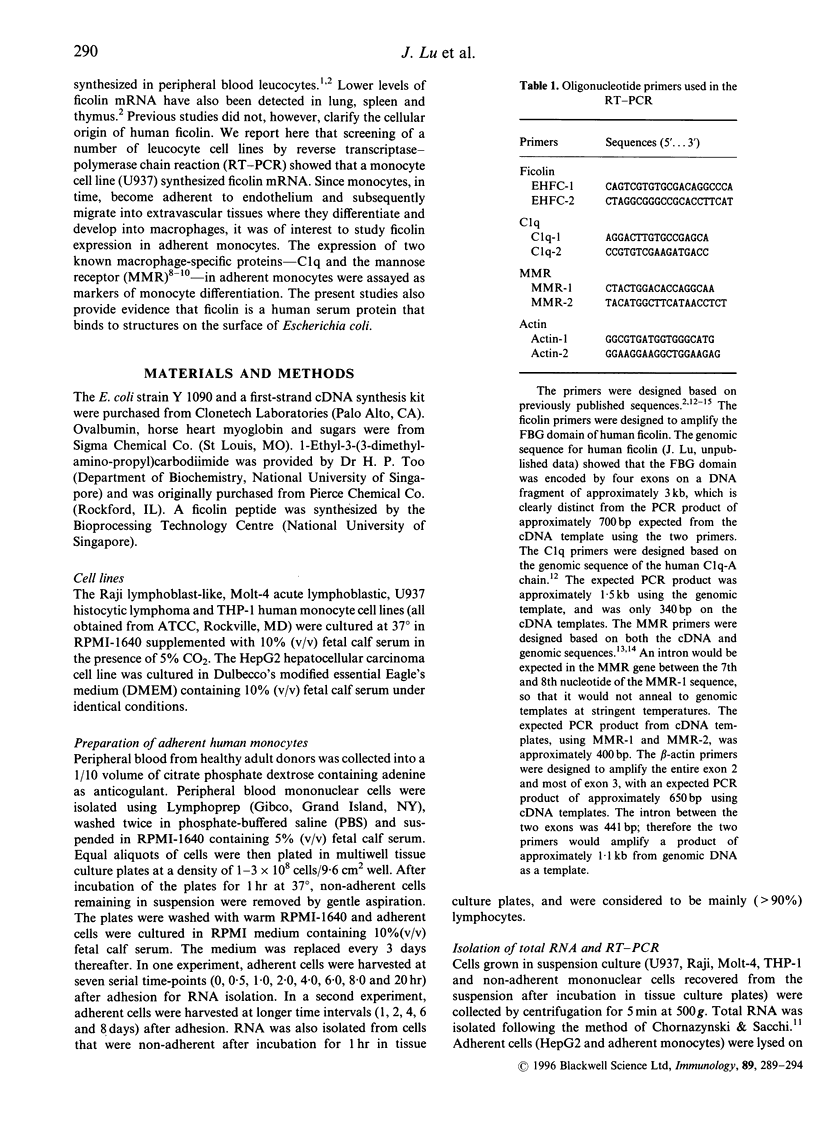
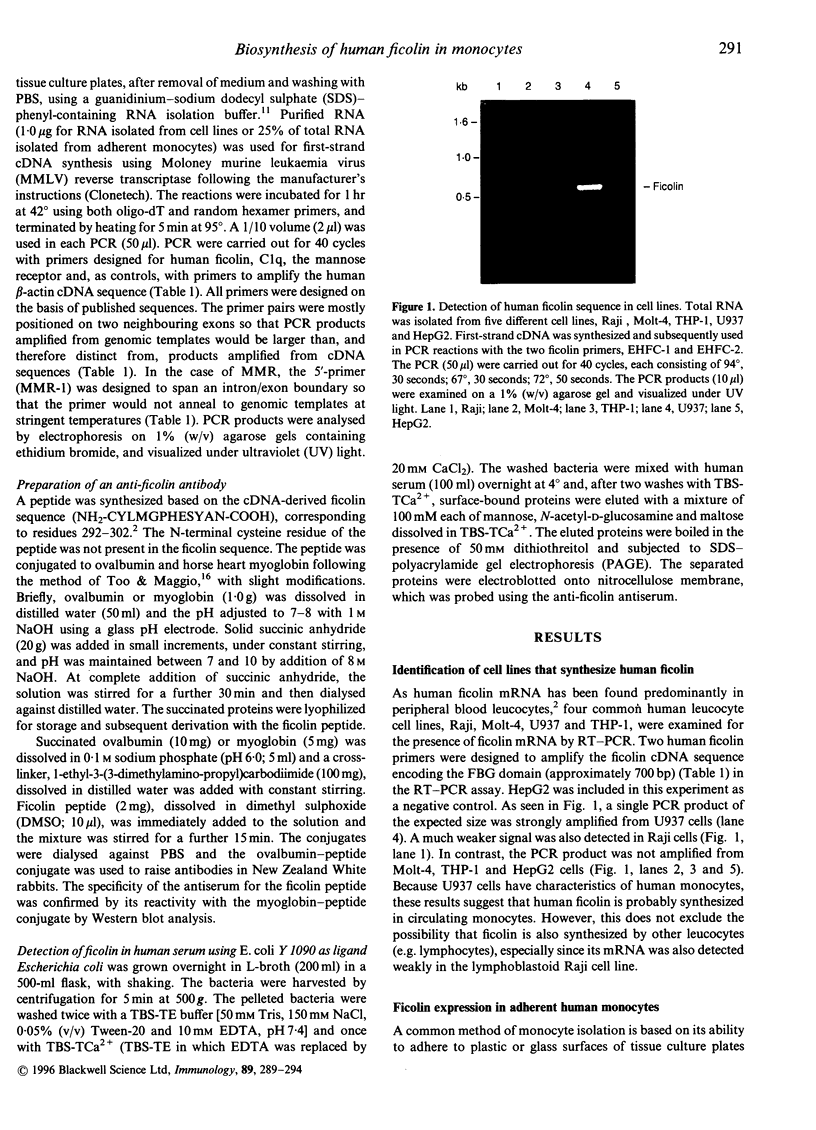
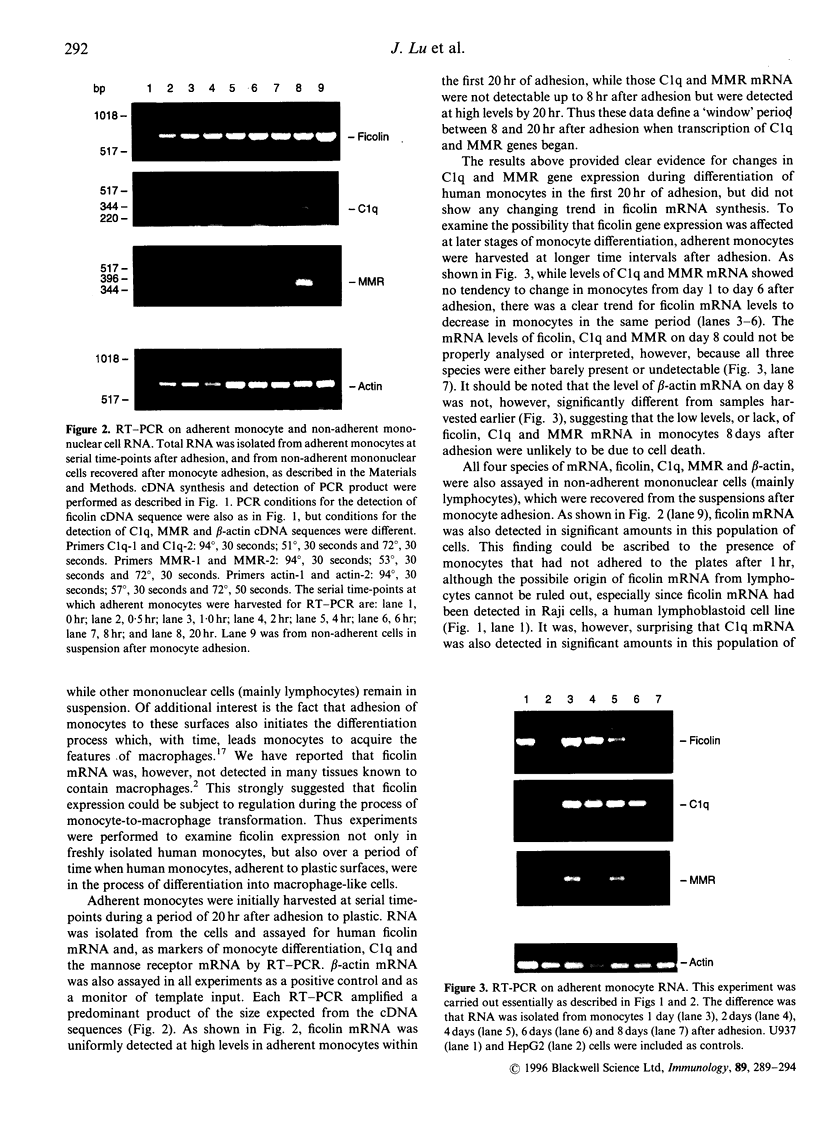
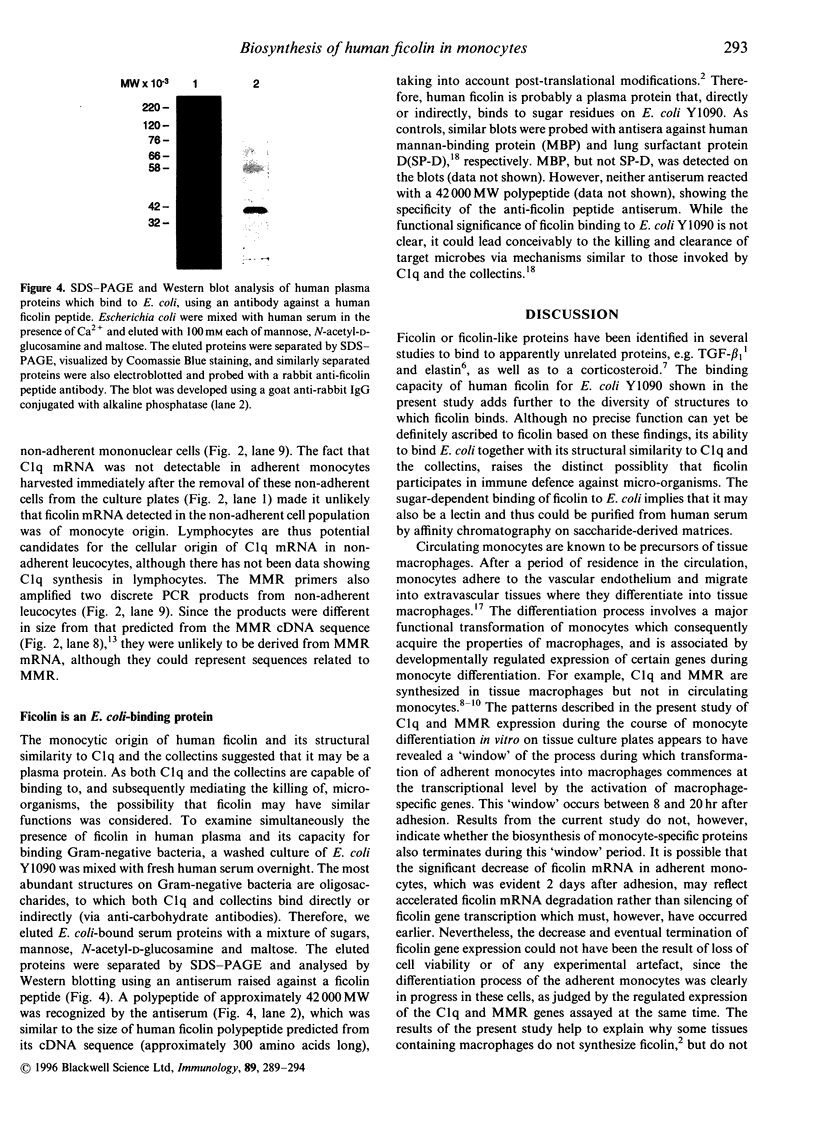
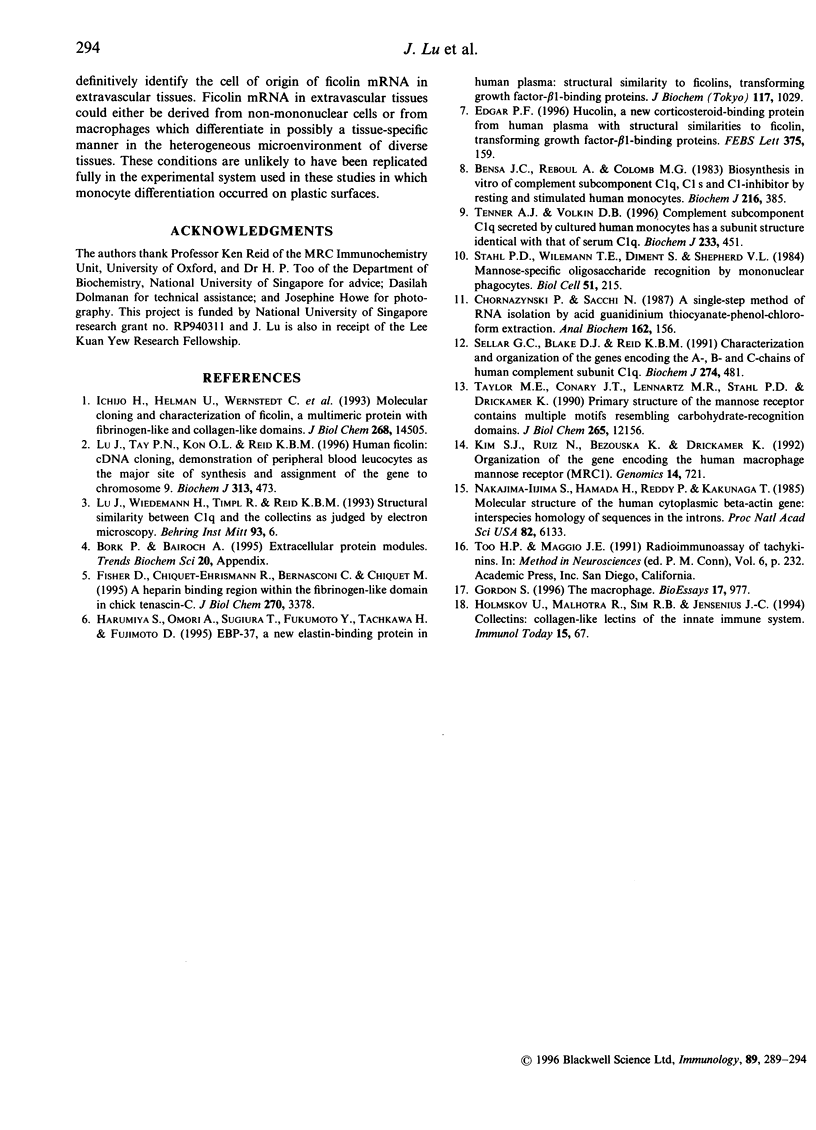
Images in this article
Selected References
These references are in PubMed. This may not be the complete list of references from this article.
- Bensa J. C., Reboul A., Colomb M. G. Biosynthesis in vitro of complement subcomponents C1q, C1s and C1 inhibitor by resting and stimulated human monocytes. Biochem J. 1983 Nov 15;216(2):385–392. doi: 10.1042/bj2160385. [DOI] [PMC free article] [PubMed] [Google Scholar]
- Chomczynski P., Sacchi N. Single-step method of RNA isolation by acid guanidinium thiocyanate-phenol-chloroform extraction. Anal Biochem. 1987 Apr;162(1):156–159. doi: 10.1006/abio.1987.9999. [DOI] [PubMed] [Google Scholar]
- Edgar P. F. Hucolin, a new corticosteroid-binding protein from human plasma with structural similarities to ficolins, transforming growth factor-beta 1-binding proteins. FEBS Lett. 1995 Nov 13;375(1-2):159–161. doi: 10.1016/0014-5793(95)01205-s. [DOI] [PubMed] [Google Scholar]
- Fischer D., Chiquet-Ehrismann R., Bernasconi C., Chiquet M. A single heparin binding region within the fibrinogen-like domain is functional in chick tenascin-C. J Biol Chem. 1995 Feb 17;270(7):3378–3384. doi: 10.1074/jbc.270.7.3378. [DOI] [PubMed] [Google Scholar]
- Gordon S. The macrophage. Bioessays. 1995 Nov;17(11):977–986. doi: 10.1002/bies.950171111. [DOI] [PubMed] [Google Scholar]
- Harumiya S., Omori A., Sugiura T., Fukumoto Y., Tachikawa H., Fujimoto D. EBP-37, a new elastin-binding protein in human plasma: structural similarity to ficolins, transforming growth factor-beta 1-binding proteins. J Biochem. 1995 May;117(5):1029–1035. doi: 10.1093/oxfordjournals.jbchem.a124802. [DOI] [PubMed] [Google Scholar]
- Holmskov U., Malhotra R., Sim R. B., Jensenius J. C. Collectins: collagenous C-type lectins of the innate immune defense system. Immunol Today. 1994 Feb;15(2):67–74. doi: 10.1016/0167-5699(94)90136-8. [DOI] [PubMed] [Google Scholar]
- Ichijo H., Hellman U., Wernstedt C., Gonez L. J., Claesson-Welsh L., Heldin C. H., Miyazono K. Molecular cloning and characterization of ficolin, a multimeric protein with fibrinogen- and collagen-like domains. J Biol Chem. 1993 Jul 5;268(19):14505–14513. [PubMed] [Google Scholar]
- Kim S. J., Ruiz N., Bezouska K., Drickamer K. Organization of the gene encoding the human macrophage mannose receptor (MRC1). Genomics. 1992 Nov;14(3):721–727. doi: 10.1016/s0888-7543(05)80174-0. [DOI] [PubMed] [Google Scholar]
- Lu J., Tay P. N., Kon O. L., Reid K. B. Human ficolin: cDNA cloning, demonstration of peripheral blood leucocytes as the major site of synthesis and assignment of the gene to chromosome 9. Biochem J. 1996 Jan 15;313(Pt 2):473–478. doi: 10.1042/bj3130473. [DOI] [PMC free article] [PubMed] [Google Scholar]
- Nakajima-Iijima S., Hamada H., Reddy P., Kakunaga T. Molecular structure of the human cytoplasmic beta-actin gene: interspecies homology of sequences in the introns. Proc Natl Acad Sci U S A. 1985 Sep;82(18):6133–6137. doi: 10.1073/pnas.82.18.6133. [DOI] [PMC free article] [PubMed] [Google Scholar]
- Sellar G. C., Blake D. J., Reid K. B. Characterization and organization of the genes encoding the A-, B- and C-chains of human complement subcomponent C1q. The complete derived amino acid sequence of human C1q. Biochem J. 1991 Mar 1;274(Pt 2):481–490. doi: 10.1042/bj2740481. [DOI] [PMC free article] [PubMed] [Google Scholar]
- Stahl P. D., Wileman T. E., Diment S., Shepherd V. L. Mannose-specific oligosaccharide recognition by mononuclear phagocytes. Biol Cell. 1984;51(2):215–218. doi: 10.1111/j.1768-322x.1984.tb00301.x. [DOI] [PubMed] [Google Scholar]
- Taylor M. E., Conary J. T., Lennartz M. R., Stahl P. D., Drickamer K. Primary structure of the mannose receptor contains multiple motifs resembling carbohydrate-recognition domains. J Biol Chem. 1990 Jul 25;265(21):12156–12162. [PubMed] [Google Scholar]
- Tenner A. J., Volkin D. B. Complement subcomponent C1q secreted by cultured human monocytes has subunit structure identical with that of serum C1q. Biochem J. 1986 Jan 15;233(2):451–458. doi: 10.1042/bj2330451. [DOI] [PMC free article] [PubMed] [Google Scholar]




